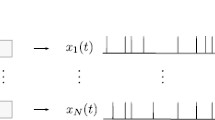Abstract
In this paper, we develop a dynamical point process model for how complex sounds are represented by neural spiking in auditory nerve fibers. Although many models have been proposed, our point process model is the first to capture elements of spontaneous rate, refractory effects, frequency selectivity, phase locking at low frequencies, and short-term adaptation, all within a compact parametric approach. Using a generalized linear model for the point process conditional intensity, driven by extrinsic covariates, previous spiking, and an input-dependent charging/discharging capacitor model, our approach robustly captures the aforementioned features on datasets taken at the auditory nerve of chinchilla in response to speech inputs. We confirm the goodness of fit of our approach using the Time-Rescaling Theorem for point processes.







Similar content being viewed by others
References
Akaike, H. (1974). A new look at the statistical model identification. IEEE Transactions on Automatic Control, 19(6), 716–723.
Allen, J. B. (1983). A hair cell model of neural response, in proceeding of the IUTAM. In E. de Boer, et al. (Eds.), ICA symposium, (Martinus, The Haugue, and Delft UP, Delft, The Netherlands) (pp. 193–202).
Anderson, D. J., Rose, J. E., Hind, J. E., & Brugge, J. F. (1971). Temporal position of discharges in single auditory nerve fibers within the cycle of a sine-wave stimulus: Frequency and intensity effects. The Journal of the Acoustical Society of America, 49, 1131.
Brown, E. N., Barbieri, R., Eden, U. T., & Frank, L. M. (2003). Likelihood methods for neural spike train data analysis. In J. Feng (Eds.), Computational neuroscience: A comprehensive approach. London: Chapman & Hall.
Brown, E. N., Barbieri, R., Ventura, V., Kass, R. E., & Frank, L.M. (2002). The time-rescaling theorem and its application to neural spike train data analysis. Neural Computation, 14, 325–346.
Brown, E. N., Frank, L. M., Tang, D., Quirk, M. C., & Wilson, M. A. (1998). A statistical paradigm for neural spike train decoding applied to position prediction from ensemble firing patterns of rat hippocampal place cells. Journal of Neuroscience, 18(18), 7411–7425.
Daley, D. J., & Vere-Jones, D. (2003). An introduction to the theory of point processes. New York: Springer.
Dallos, P., & Harris, D. (1978). Properties of auditory nerve responses in absence of outer hair cells. Journal of Neurophysiology, 41(2), 365–383.
Fletcher, H. (1952). Speech and hearing in communication’. New York: Van Nostrand.
Heffner, R. S., & Heffner, H. E. (1991). Behavioral hearing range of the chinchilla. Hearing Research, 52(1), 13–6.
Heil, P., & Neubauer, H. (2003). A unifying basis of auditory thresholds based on temporal summation. Proceedings of the National Academy of Sciences, 100(10), 6151–6156.
Johnson, D. H. (1974). The response of single auditory-nerve fibers in the cat to single tones;, synchrony and average discharge rate. PhD thesis, Massachusetts Institute of Technology.
Johnson, D. H. (1980). The relationship between spike rate and synchrony in responses of auditory-nerve fibers to single tones. The Journal of the Acoustical Society of America, 68, 1115.
Raybould, N. P., Jagger, D. J., & Housley, G. D. (2001). Positional analysis of guinea pig inner hair cell membrane conductances: Implications for regulation of the membrane filter. JARO-Journal of the Association for Research in Otolaryngology, 2(4), 362–376.
Sewell, W. F. (1984). The relation between the endocochlear potential and spontaneous activity in auditory nerve fibres of the cat. The Journal of Physiology, 347(1), 685–696.
Shannon, R. V., Zeng, F. G., Kamath, V., Wygonski, J., & Ekelid, M. (1995). Speech recognition with primarily temporal cues. Science, 270(5234), 303.
Stevens, H. E., & Wickesberg, R. E. (1999). Ensemble responses of the auditory nerve to normal and whispered stop consonants. Hearing Research, 131(1–2), 47–62.
Truccolo, W., Eden, U. T., Fellows, M. R., Donoghue, J. P., & Brown, E. N. (2005). A point process framework for relating neural spiking activity to spiking history, neural ensemble, and extrinsic covariate effects. Journal of Neurophysiology, 93, 1074–1089.
Von Békésy, G. (1944). Über die mechanische Frequenzanalyse in der Schnecke verschiedener Tiere. Akustičeskij Zǔrnal, 9, 3–11.
Wegel, R. L., & Lane, C. E. (1924). The auditory masking of one pure tone by another and its probable relation to the dynamics of the inner ear. Physical Review, 23(2), 266–285.
Weiss, T. F., Mulroy, M. J., & Altmann, D. W. (1974). Intracellular responses to acoustic clicks in the inner ear of the alligator lizard. The Journal of the Acoustical Society of America, 55, 606.
Wever, E. G., & Bray, C. W. (1937). The perception of low tones and the resonance-volley theory. Journal of Psychology, 3, 101–114.
Zhang, X., Heinz, M. G., Bruce, I. C., & Carney, L. H. (2001). A phenomenological model for the responses of auditory-nerve fibers: I. Nonlinear tuning with compression and suppression. The Journal of the Acoustical Society of America, 109, 648.
Acknowledgements
The authors would like to first thank Bob Wickesberg and Hanna Stevens, for the rich dataset that made this work possible; Emery Brown for his advice and mentorship; Anne Dreyer for her input on modeling auditory spikes; and Bryce Lobdell, for his input on using critical bandwidth filters.
A. Trevino would like to acknowledge the financial support from the UIUC SURGE fellowship, the NIH-UIUC Sensory Neuroscience Training Grant, and the NSF Graduate Research Fellowship. T. P. Coleman would like to acknowledge the financial support from the AFOSR Complex Networks Program via award no FA9550-08-1-0079.
Author information
Authors and Affiliations
Corresponding author
Additional information
Action Editor: S. A. Shamma
Rights and permissions
About this article
Cite this article
Trevino, A., Coleman, T.P. & Allen, J. A dynamical point process model of auditory nerve spiking in response to complex sounds. J Comput Neurosci 29, 193–201 (2010). https://doi.org/10.1007/s10827-009-0146-6
Received:
Revised:
Accepted:
Published:
Issue Date:
DOI: https://doi.org/10.1007/s10827-009-0146-6




